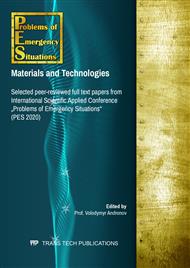[1]
V.V. Tiutiunyk, H.V. Ivanets, I.A. Tolkunov, E.I. Stetsyuk, System approach for readiness assessment units of civil defense to actions at emergency situations, Naukovyi Visnyk Natsionalnoho Hirnychoho Universytetu. 1 (2018) 99-105.
DOI: 10.29202/nvngu/2018-1/7
Google Scholar
[2]
M.I. Vasiliev, I.O. Movchan, O.M. Koval, Diminishing of ecological risk via optimization of fire-extinguishing system projects in timber-yards, Naukovyi Visnyk Natsionalnoho Hirnychoho Universytetu. 5 (2014) 106-113.
DOI: 10.29202/nvngu
Google Scholar
[3]
Y. Otrosh, A. Kovaliov, O. Semkiv, I. Rudeshko, V. Diven, Methodology remaining lifetime determination of the building structures, MATEC Web of Conferences. 230 (2018) 02023.
DOI: 10.1051/matecconf/201823002023
Google Scholar
[4]
Y. Otrosh, M. Surianinov, A. Golodnov, O. Starova, Experimental and Computer Researches of Ferroconcrete Beams at High-Temperature Influences, In Materials Science Forum. 968 (2019) 355-360.
DOI: 10.4028/www.scientific.net/msf.968.355
Google Scholar
[5]
A. Vasilchenko, E. Doronin, O. Chernenko, I. Ponomarenko, Estimation of fire resistance of bending reinforced concrete elements based on concrete with disperse fibers, In IOP Conference Series: Materials Science and Engineering. 708 (1) (2019) p.012075.
DOI: 10.1088/1757-899x/708/1/012075
Google Scholar
[6]
V.I. Morozov, Ju.V Puharenko, Jeffektivnost' primenenija fibrobetona v konstrukcijah pri dinamicheskih vozdejstvijah, Vestnik MGSU. (2014) 189-196.
Google Scholar
[7]
N.E. Gafarova, Fibrobeton dlja sejsmoopasnyh rajonov stroitel'stva, Mezhdunarodnyj zhurnal prikladnyh i fundamental'nyh issledovanij. 9(2) (2016) 179-181.
Google Scholar
[8]
K. Wille, S. El-Tawil, A.E. Naaman, Properties of strain hardening ultra high performance fiber reinforced concrete (UHP-FRC) under direct tensile loading, Cement and Concrete Composites. 48 (2014) 53-66.
DOI: 10.1016/j.cemconcomp.2013.12.015
Google Scholar
[9]
Ju.V. Puharenko, Nauchnye i prakticheskie osnovy formirovanija struktury i svojstv fibrobetonov, avtoref. diss. ... dok. tehn. nauk. 2004. 46 s.
Google Scholar
[10]
F.N. Rabinovich, Kompozity na osnove dispersno-armirovannyh betonov, Voprosy teorii i proektirovanija, tehnologii, konstrukcii, Moskva. 2004. 560 s.
Google Scholar
[11]
T. Haktanir, K. Ari, F. Altun, C.D. Atis, O. Karahan, Effects of steel fibers and mineral filler on the water-tightness of concrete pipes, Cement and Concrete Composites. 28(9) (2006) 811 - 816.
DOI: 10.1016/j.cemconcomp.2006.06.002
Google Scholar
[12]
V. Bhikshma, K. Manipal, Study on mechanical properties of recycled aggregate concrete containing steel fibers, Asian Journal of Civil Engineering (Building and Housing). 13(2) (2012) 155 - 164.
Google Scholar
[13]
V. Bhikshma, J.L. Singh, Investigations on mechanical properties of recycled aggregate concrete containing steel fibers, Indian Concrete Institute Journal. 4-9 (10) (2010) 15-19.
Google Scholar
[14]
P.S. Shah, V.K. Rangan, Effect of fiber addition on concrete strength, Indian Concrete Journal. vol. 5, no. 2–6 (5) (1994) 13–21.
Google Scholar
[15]
M.H.F. Rasheed, A.Z.S. Agha, Analysis of Fibrous Reinforced Concrete Beams. Engineering and Technical Journal. 30 (6) (2012) 974–987.
Google Scholar
[16]
A.M. Bragov, B.L. Karihalu, A.Ju. Konstantinov, D.A. Lamzin, A.K., Lomunov. Issledovanie mehanicheskih svojstv fibrobetona s pomoshh'ju metodiki Kol'skogo i ee modifikacij, Vestnik Nizhegorodskogo universiteta im. N.I. Lobachevskogoю. 4 (1) (2011) 123-129.
Google Scholar
[17]
I.A. Leonovich, Prochnostnye svojstva fibrobetona s zapolnitelem iz mikrosfer napolnitelem pri udarnom nagruzhenii, Vestnik Belorussko-Rossijskogo universiteta. 2(19) (2008) 129-136.
Google Scholar
[18]
Y. Wang, S. Backer, Toughness determination for fibre reinforced concrete, International Journal of Cement Composites and Lightweight Concrete. 11(1) (1989) 11-19.
DOI: 10.1016/0262-5075(89)90031-6
Google Scholar
[19]
V.S. Gopalaratnam, S.P. Shah, G. Batson, M. Criswell, V. Ramakishnan and M. Wecharatana, Fracture Toughness of Fiber Reinforced Concrete, Materials Journal. 88 (4) (1991) 339-353.
Google Scholar
[20]
BS EN 14889-1:2006 Fibres for concrete. Steel fibres. Definitions, specifications and conformity.
DOI: 10.3403/30110332u
Google Scholar
[21]
DSTU-N B V.2.6-78:2009, Nastanova z proektuvannia ta vyhotovlennia stalefibrobetonnykh konstruktsii, Natsionalnyi standart Ukryiny, Kyiv. 2009. 43 s.
Google Scholar
[22]
DSTU-N B V.2.6-218:2016 Nastanova z proektuvannia ta vyhotovlennia konstruktsii z dyspersnoarmovanoho betonu, Kyiv, 2017. 35 s.
Google Scholar
[23]
E. Bruhwiler, Rehabilitation and strengthening of concrete structures using Ultra-High Perfor-mance Fibre Reinforced Concrete, Concrete Repair, Rehabilitation and Retrofitting III – Alexander et al. (eds) Taylor & Francis Group, London, 2012. pp.72-79.
DOI: 10.1201/b12750-12
Google Scholar


